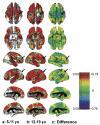Anatomical brain magnetic resonance imaging of typically developing children and adolescents
- PMID: 19395901
- PMCID: PMC2892679
- DOI: 10.1097/CHI.0b013e31819f2715
Anatomical brain magnetic resonance imaging of typically developing children and adolescents
Figures



References
-
- Mackie S, Shaw P, Lenroot R, et al. Cerebellar development and clinical outcome in attention deficit hyperactivity disorder. Am J Psychiatry. 2007;164:647–655. - PubMed
-
- Lange N, Giedd JN, Castellanos FX, Vaituzis AC, Rapoport JL. Variability of human brain structure size: ages 4 to 20. Psychiatry Res. 1997;74:1–12. - PubMed
-
- Caviness VSJ, Kennedy DN, Richelme C, Rademacher J, Filipek PA. The human brain age 7–11 years: a volumetric analysis based on magnetic resonance images. Cereb Cortex. 1996;6:726–736. - PubMed
Publication types
MeSH terms
Grants and funding
LinkOut - more resources
Full Text Sources
Other Literature Sources

